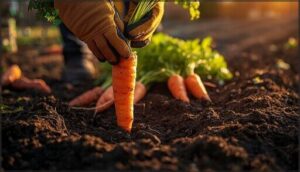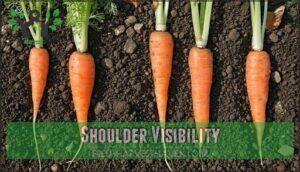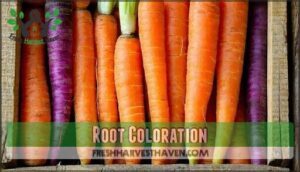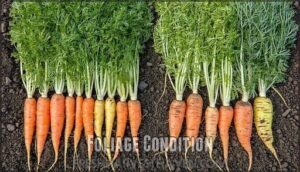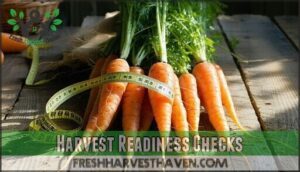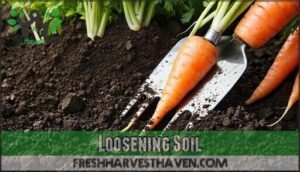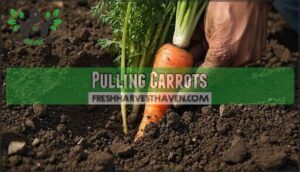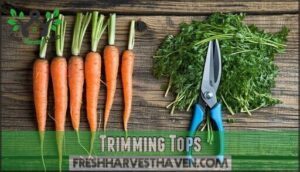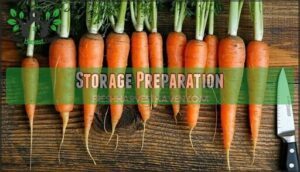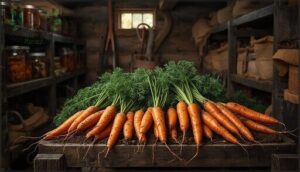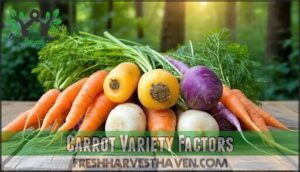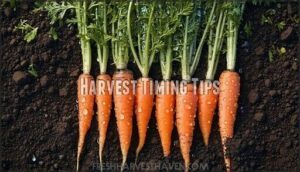This site is supported by our readers. We may earn a commission, at no cost to you, if you purchase through links.
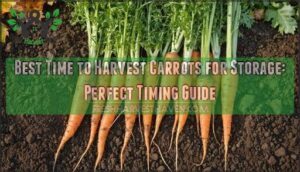
Wait until cool autumn weather arrives but before hard frost hits – this sweet spot converts starches to sugars while keeping cell walls intact.
Check that carrot tops show vibrant orange color peeking above ground and feel firm when gently squeezed.
Morning harvests work best when soil moisture is just right.
Don’t rush the process – patience pays off with carrots that’ll keep for months rather than weeks.
Table Of Contents
- Key Takeaways
- Harvest Timing Factors
- Carrot Maturity Signs
- Harvest Readiness Checks
- Harvesting Techniques
- Storage Preparation
- Short Term Storage
- Long Term Storage
- Carrot Variety Factors
- Harvest Timing Tips
- Post Harvest Care
- Frequently Asked Questions (FAQs)
- When should I Harvest carrots?
- How do you store carrots after harvest?
- How do you harvest carrots in summer?
- Can you harvest carrots in one go?
- Can you store carrots in the ground during winter?
- Can you harvest carrots after Frost?
- What is the best way to store fresh picked carrots?
- How do I know when my carrots are ready to pick?
- What happens if you leave carrots in the ground too long?
- Is it better to store carrots washed or unwashed?
- Conclusion
Key Takeaways
- You’ll get the best storage carrots by harvesting 70-80 days after planting when shoulders measure ¾ to 1 inch across and show deep orange color at soil level.
- You should harvest during cool autumn weather before hard frost hits – this converts starches to sugars while keeping cell walls intact for longer storage.
- You’ll achieve easier extraction and better quality by watering the day before harvest, then pulling carrots during cool morning hours when plant stress is minimal.
- You must trim green tops immediately after harvest, leaving ½ inch of stem, then store unwashed carrots in perforated bags or pack in damp sand for maximum shelf life.
Harvest Timing Factors
You’ll need to examine three main factors when determining the ideal harvest time for your storage carrots: days to maturity, current weather conditions, and your soil quality.
These elements work together to influence when your carrots reach peak storage readiness, typically occurring between 60 to 80 days after planting depending on the variety you’ve chosen, which is a key factor in achieving peak storage readiness.
Master the 60-80 day window when varieties hit their sweet spot for maximum storage potential.
Days to Maturity
Your seed packet’s days to maturity estimates provide the foundation for harvest timing, typically ranging from 50 to 110 days after planting.
However, these numbers aren’t gospel—variety differences and regional variations can extend maturity by 2-3 weeks.
Fast-growing Nantes carrots mature in 50 days, while storage varieties like Danvers need 65-80 days for ideal development, and understanding these variety differences is crucial.
Weather Conditions
Weather conditions play a major role in determining your carrot harvest time.
Temperature effects and seasonal variation directly influence carrot sweetness – cooler temperatures actually boost sugar content.
Cooler weather transforms starches into natural sugars, making your carrots sweeter with each chilly night.
Rainfall impact affects soil moisture levels, making extraction easier after light rain.
Frost tolerance allows carrots to stay in ground longer, enhancing carrot flavor.
Monitor sunlight exposure and frost impact for ideal timing.
Soil Quality
Good soil quality dramatically impacts when your carrots reach peak harvest readiness.
Your soil’s composition, pH levels, and drainage directly affect root development timing and storage potential.
- Soil pH: Maintain 6.0-6.8 for ideal nutrient uptake
- Soil drainage: Guarantee loose, well-draining conditions prevent rot
- Soil nutrients: Balanced fertilization promotes steady growth
- Soil amendments: Add compost for improved texture and timing
Adding compost and other organic matter additions improves soil health.
Carrot Maturity Signs
You’ll know your carrots are ready when their shoulders measure at least one inch across and peek through the soil surface.
Look for deep orange coloration and healthy green foliage that stands 10-12 inches tall, which indicates the roots have reached full maturity.
Shoulder Visibility
Carrot shoulders poking through soil surface signal readiness for harvest.
Look for the top portion of your carrots emerging from the ground – this exposed shoulder reveals diameter and maturity level.
Check visibility factors like soil erosion around plants, which naturally exposes carrot tops over time.
| Shoulder Exposure Level | Diameter Indication | Harvest Readiness |
|---|---|---|
| Barely visible | Less than ¾ inch | Wait 1-2 weeks |
| Partially exposed | ¾ to 1 inch | Nearly ready |
| Fully visible | 1+ inches | Ready to harvest |
Root Coloration
Once you’ve spotted those visible shoulders, pay attention to your carrot’s color development. Rich, vibrant hues signal peak maturity and maximum storage potential. Deep orange carrots with uniform pigment intensity throughout the root indicate proper ripeness, while pale or uneven coloration suggests they need more time to develop their full flavor profile.
Knowing when to harvest is key, so observe carrot shoulders for the best results.
- Deep orange coloration indicates maximum sugar content and maximum carrot quality
- Uniform color distribution from shoulder to tip shows complete maturity for storage
- Varietal colors like purple, yellow, or white should display their characteristic intensity
- Consistent pigment intensity throughout the root helps guarantee better flavor retention during storage
Foliage Condition
Check your carrot foliage for key maturity signals that reveal harvest readiness.
Healthy foliage stands 10-12 inches tall with dense green color, while yellowing foliage or flopping foliage indicates peak ripeness.
Small, underdeveloped carrot tops suggest more growing time needed.
| Foliage Condition | Harvest Status |
|---|---|
| Lush Green Density, 10-12" Height | Ready to Harvest |
| Yellowing Foliage, Flopping | Peak Maturity |
| Small, Pale Carrot Tops | Needs More Time |
Harvest Readiness Checks
You’ll need to perform specific physical checks to determine if your carrots have reached ideal harvest size for storage.
These measurements focus on shoulder diameter and overall root development, which directly indicate storage potential and quality.
You’ll need to perform specific physical checks to determine if your carrots have reached ideal harvest size for storage. These measurements focus on shoulder diameter and overall root development, which directly indicate storage potential and quality.
harvest-readiness-intro
text/markdown
Harvest Readiness Checks Introduction
You’ll need to perform specific physical checks to determine if your carrots have reached ideal harvest size for storage. These measurements focus on shoulder diameter and overall root development, which directly indicate storage potential and quality.
Shoulder Diameter
Measuring shoulders provides the most reliable carrot maturity indicators for determining harvest timing.
The carrot shoulder develops as the top portion of the root near soil level, serving as your primary harvest indicator.
Here’s how to assess shoulder development:
- Ideal Diameter: Look for shoulders measuring ¾ to 1 inch across
- Measuring Shoulders: Gently brush away soil to expose the top portion
- Diameter Variation: Account for variety differences in expected carrot diameter
Root Size
Beyond shoulder diameter, you’ll want to assess overall carrot size for ideal harvest timing.
Most mature carrots reach 6-8 inches in length with an ideal diameter of ¾ to 1 inch.
Variety differences affect mature length substantially—baby carrots peak at 3-4 inches while storage types grow 8-10 inches.
Growth rate depends on soil impact and moisture levels throughout the season, which are crucial for ideal harvest timing.
Harvesting Techniques
You’ll need to follow specific steps to extract carrots properly without damaging the roots or compromising their storage potential.
Water your carrot bed the day before harvest, then use a garden fork to loosen the soil around each plant before pulling them straight up by their green tops, this is crucial for preserving the roots.
Loosening Soil
The best time to harvest carrots requires proper soil loosening first.
Water your garden bed the day before harvesting carrots to soften compacted earth.
Position your trowel technique six inches from carrot shoulders, avoiding root protection damage.
Fork placement should penetrate deeply around each plant.
Ideal soil moisture makes carrot harvesting effortless, while proper tool selection prevents breaking during soil loosening operations.
Consider using a specialized garden tool for optimal results and to ensure effortless carrot harvesting.
Pulling Carrots
Once your soil’s loose, you’re ready for the main event.
Gentle extraction prevents damage to your precious roots. Grab each carrot where the greens meet the root, then pull straight up with steady pressure. A slight wiggle helps, but avoid yanking like you’re starting a lawnmower.
Here’s your carrot-pulling playbook:
- Grip at the crown – Hold where foliage meets the root for maximum control
- Pull vertically – Straight up motion prevents breaking or bending roots
- Use steady pressure – Consistent force works better than sudden jerks
- Wiggle gently – Small side-to-side motion helps stubborn carrots release
For assistance, consider using a specialized tool for pulling.
Trimming Tops
After harvesting carrots, immediate foliage trimming prevents moisture loss and spoilage.
Cut greens leaving half-inch stems—this stem length blocks bacteria entry while maintaining flavor retention.
Don’t skip this step; untrimmed tops drain energy from roots.
These carrot storage tips guarantee your harvesting carrots effort pays off with extended carrot storage duration through proper top trimming techniques, ensuring proper top trimming is crucial for long-term preservation.
Storage Preparation
Once you’ve harvested your carrots, proper preparation determines how long they’ll stay fresh and flavorful in storage.
You’ll need to remove the green tops, decide whether to wash the roots, and allow them to dry completely before placing them in your chosen storage method.
Removing Greens
Once you’ve pulled your carrots from the ground, foliage trimming becomes your next priority for proper carrot storage.
Cut the carrot greens immediately, leaving about half an inch of stem length attached to the root.
This spoilage prevention step stops moisture from escaping through the leaves, ensuring flavor retention.
Quick removal of greens protects your harvesting carrots investment through effective moisture preservation.
Washing Carrots
Once you’ve trimmed the greens, you’ll need to decide whether carrot washing is necessary.
Washing benefits include removing dirt and debris, but it also reduces storage life.
For immediate use, gentle carrot cleaning with cool water works well. Avoid detergent usage entirely.
For long-term carrot storage, skip carrot rinsing completely. Dirt removal can happen later when you’re ready to cook.
Drying Roots
After washing your mature carrots, proper drying prevents spoilage and extends storage life.
Excess moisture creates the perfect breeding ground for rot, so you’ll want those roots bone-dry before storing.
Here are your top dehydration methods:
- Air drying – Spread carrots on clean towels for 2-3 hours
- Paper towel patting – Gently remove surface moisture
- Rack drying – Use cooling racks for better airflow
- Fan assistance – Speed up the process with gentle circulation
- Temperature control – Keep drying area cool and well-ventilated
Short Term Storage
When you harvest carrots for storage lasting 2-4 weeks, you’ll need to wash them thoroughly and store them in perforated plastic bags in your refrigerator.
The key to successful short-term storage is maintaining proper humidity levels around 95% while keeping temperatures between 32°F and 40°F, which is crucial for successful storage.
Refrigeration
Your fridge temperature should stay between 32°F and 40°F for ideal carrot storage conditions.
Store freshly harvested carrots in the crisper drawer where humidity levels remain high.
Keep storage containers away from apples and pears to prevent ethylene exposure, which speeds decay.
To further extend their usability, consider blanching vegetables beforehand.
Proper refrigerator storage extends shelf life to 2-4 weeks, maintaining carrot freshness throughout, and ensuring longer storage.
Perforated Bags
Plastic bags with tiny holes work like carrot breathing apparatus.
Choose medium-thickness bags with quarter-inch holes spaced two inches apart for ideal airflow.
This bag material prevents condensation buildup while maintaining moisture levels essential for storing carrots.
Proper hole size extends shelf life by balancing air circulation with humidity retention, keeping your harvested carrots crisp for weeks, which is achieved by ideal airflow and maintaining the right level of moisture.
Humidity Control
Beyond bagged storage, ideal levels of humidity keep your carrots crisp without turning them into mushy disappointments.
Maintain 90-95% humidity in your storage environment while ensuring proper air circulation prevents condensation buildup.
Consider humidity monitoring tools for precision – they’re game-changers for winter storage success, as good vegetable storage relies on this delicate balance between moisture retention and condensation prevention when storing harvested carrots.
Long Term Storage
For long-term storage, you’ll need to harvest carrots at their peak maturity when they’re fully developed and rich in color.
Proper techniques like freezing, canning, or using root cellars help preserve their quality for months, utilizing methods such as canning to maintain freshness.
Freezing
Freezing carrots is a smart way to extend their shelf life while preserving nutrients.
Start by blanching carrots to prevent texture changes and maintain color.
Follow these steps:
- Blanch: 2-5 minutes based on size.
- Flash freeze: Arrange carrots on a tray to avoid clumping.
- Store: Use airtight containers to prevent freezer burn.
- Choose the best varieties like ‘Nantes.’
For ideal results, consider water blanching techniques before freezing to achieve the best outcome with complete concepts in mind.
Canning
Canning methods require pressure canners for safe carrot preservation since they’re low-acid vegetables.
You’ll need proper jar preparation with sterilized containers and fresh lids. Processing times vary: 25 minutes for pints, 30 for quarts at 10 pounds pressure.
Canning safety demands following USDA-approved recipes exactly. This vegetable storage solution offers shelf-stable carrot canning for 12-18 months without refrigeration.
Canned carrots are a versatile option, and have minimal nutritional differences compared to fresh.
Root Cellars
Underground storage spaces offer the gold standard for carrot preservation techniques.
Root cellar construction requires maintaining 32-40°F temperatures with 85-95% humidity levels. Proper ventilation needs prevent ethylene buildup while ensuring ideal carrot storage methods.
When harvesting carrots at the best time harvest, you’ll maximize their storage potential through controlled environmental conditions. Many gardeners find supplies for root cellars helpful for efficient storage.
- Temperature control systems maintain consistent 32-40°F ranges for extended carrot preservation
- Humidity regulation at 85-95% prevents dehydration while avoiding excess moisture buildup
- Root cellar alternatives include insulated basements or purpose-built underground storage chambers
Carrot Variety Factors
Different carrot varieties mature at different rates, with fast-growing types like ‘Napoli’ ready in 55 days while storage varieties like ‘Merida’ need 80 days or more.
You’ll need to match your variety’s maturation rate and storage potential to your harvest timing, since storage-type carrots typically hold better in long-term conditions than quick-maturing varieties, considering their maturation rate.
Maturation Rates
Understanding carrot maturity rates helps you time your harvest perfectly.
Different varieties mature at vastly different speeds, with some ready in just 50 days while others need 110 days.
Growth stages vary based on rate determinants like temperature and soil conditions.
| Variety | Days to Maturity |
|---|---|
| Napoli | 55 days |
| Nantes | 60 days |
| Danvers | 65 days |
| Paris Market | 70 days |
| Merida | 80+ days |
The ability to understand and apply this knowledge can lead to a perfectly timed harvest, which is crucial for maximizing the yield and quality of the carrots.
Storage Potential
Different carrot varieties offer vastly different storage potential, making variety selection essential for extending freshness.
Storage-type carrots like ‘Bolero’ and ‘Hercules’ maintain quality for months when stored properly, while tender varieties deteriorate within weeks.
These ideal varieties resist flavor changes and nutritional impact during storage, which helps in understanding carrot storage duration by variety to choose the right cultivars for your harvesting carrots timeline and storage goals.
To maximize longevity, consider maintaining proper humidity during storage, ensuring that you can enjoy your carrots for a longer period with optimal freshness.
Flavor Profile
Several factors shape your carrot’s flavor profile and determine ideal harvest timing.
Sweetness development peaks when roots reach full maturity, while premature harvesting creates bland, bitter carrots.
Cold exposure enhances natural sugars, improving carrot taste substantially.
Different varietal flavors range from mild to robust.
Proper timing prevents texture changes and bitterness factors, ensuring excellent flavor preservation during storage.
Harvest Timing Tips
You’ll achieve better storage results when you harvest carrots during cool morning hours, ideally after watering the soil the day before.
This timing combination guarantees maximum moisture retention in the roots while making extraction easier and reducing plant stress during the harvest process, which is crucial for reducing plant stress.
Morning Harvests
Timing your carrot harvest for early morning delivers maximal sweetness and preserved moisture.
Cool dawn temperatures reduce plant stress while maintaining peak flavor compounds.
Morning harvest guarantees the best carrot harvesting timing for storage success.
Consider these morning harvest advantages:
- Reduced stress from cooler temperatures
- Preserved moisture content in roots
- Enhanced sweetness from overnight sugar concentration
- Dry conditions prevent excess surface moisture
- Preferred carrot harvesting best practices timing
The advantages of morning harvest include reduced plant stress and preserved moisture.
This results in enhanced sweetness and better storage success.
Cool Weather
Cool weather transforms your carrots into sweet storage treasures.
Fall harvest timing after the first light frost creates a natural sweetness boost as starches convert to sugars.
Regional variations affect this process, but temperatures between 32-40°F optimize carrot maturity signs.
Late harvest during cool conditions provides significant storage benefits, extending shelf life while enhancing flavor profiles for winter enjoyment.
Soil Moisture
Proper soil moisture sets the stage for smooth carrot harvesting techniques.
Water your carrots the day before harvest to soften compacted soil and prevent root damage. Adequate moisture retention helps maintain carrot texture and flavor during extraction.
However, avoid overwatering, which can lead to root rot and poor soil drainage, making harvest difficult and compromising storage quality, as proper soil moisture is crucial for smooth carrot harvesting techniques.
Post Harvest Care
After you’ve harvested your carrots, proper care determines how long they’ll stay fresh and tasty in storage.
You’ll need to check your stored carrots regularly, remove any that show signs of rot, and maintain the right conditions to extend their shelf life for months.
Regular Checks
After establishing your harvest timing guide, ongoing inspection becomes your best friend for determining peak readiness.
You’ll want to check your carrots every few days as they approach maturity, monitoring key indicators that signal prime harvest time.
- Size Assessment: Measure shoulder diameter weekly – aim for 3/4 to 1 inch width
- Color Monitoring: Look for deep orange hues developing throughout the root
- Texture Checks: Gently squeeze shoulders to assess firmness and density
Rot Prevention
Preventing carrot rot starts with proper wound sealing after trimming tops.
Clean cuts heal faster than ragged tears.
Airflow importance can’t be overstated – stack carrots loosely in your storage medium.
Humidity control prevents moisture buildup that causes decay.
Choose variety resistance when planning future crops.
These carrot storage best practices protect your harvest from spoilage better than any carrot harvesting methods alone, using proper wound sealing, airflow importance, and humidity control.
Shelf Life Extension
You’ll dramatically extend your carrot’s shelf life by implementing controlled humidity systems and modified atmosphere packaging.
Anti-fungal treatments prevent decay while ethylene control stops premature aging.
These carrot storage best practices, combined with proper temperature management and irradiation methods, transform your longterm storage success.
Following these carrot freshness tips and harvesting best practices guarantees maximum preservation quality.
Frequently Asked Questions (FAQs)
When should I Harvest carrots?
Harvest your carrots 60-80 days after planting when shoulders measure about one inch across and peek through soil.
Check seed packets for variety-specific timing, then pull a test carrot to confirm sweetness.
How do you store carrots after harvest?
Remove carrot tops, leaving one inch of stem to prevent moisture loss.
Store unwashed carrots in perforated plastic bags in your refrigerator’s crisper drawer, or pack them in damp sand for longer preservation.
How do you harvest carrots in summer?
Water your carrots the day before you plan to harvest them.
This softens the soil and makes pulling easier.
Gently loosen soil around each carrot with a trowel, then pull straight up by the greens.
Can you harvest carrots in one go?
Why pull each carrot individually when you can harvest your entire crop efficiently?
You can absolutely harvest carrots in one go by loosening soil around the entire row, then pulling them systematically for maximum efficiency.
Can you store carrots in the ground during winter?
Yes, you can store carrots in the ground during winter by covering them with thick mulch or straw. They’ll survive until the first hard freeze, becoming sweeter after cold exposure.
Can you harvest carrots after Frost?
Light frost actually sweetens carrots by converting starches to sugars.
You can safely harvest them after mild frosts, but pull them before hard freezes damage the roots and make storage difficult.
What is the best way to store fresh picked carrots?
Trim carrot tops, leaving about an inch of stem, then store unwashed carrots in a perforated plastic bag in the fridge.
For long-term storage, pack them in moist sand or sawdust at cool, humid temperatures.
How do I know when my carrots are ready to pick?
Contrary to popular belief, carrots don’t announce their readiness with obvious signs.
Check if shoulders measure about one inch diameter and peek above soil after 60-80 days from planting—that’s your green light.
What happens if you leave carrots in the ground too long?
Leaving carrots in the ground too long causes them to develop a woody, bitter core and crack.
They’ll lose their sweet flavor and tender texture, becoming tough and unpalatable for eating.
Is it better to store carrots washed or unwashed?
Like a protective blanket shields precious treasures, soil naturally preserves your carrots’ freshness.
Store them unwashed—washing removes their natural protective layer and invites rot.
Simply brush off excess dirt and they’ll stay crisp for weeks longer.
Conclusion
Mastering the best time to harvest carrots for storage might seem like rocket science, yet it’s surprisingly straightforward once you understand the basics.
You’ll achieve maximum storage life by waiting for that 70-80 day maturity window, checking shoulder diameter, and harvesting during cool morning hours.
Your patience during those final weeks translates directly into months of fresh carrots rather than premature spoilage.
Follow these timing guidelines, and you’ll transform your garden harvest into a winter-long supply of crisp, sweet carrots.
- https://greatgardenplans.com/when-to-pick-carrots-in-garden/
- https://www.johnnyseeds.com/growers-library/vegetables/carrots/carrot-harvest-handling-storage.html?srsltid=AfmBOop0JGDe89DPfwW42VyWX9aa6awiaG1AGOUdJzJVfOwAvl8f09nj
- https://savvygardening.com/when-to-harvest-carrots/
- https://veggieknowledge.com/when-to-harvest-carrota/
- https://stonepostgardens.com/it-is-time-to-harvest-our-carrots/

